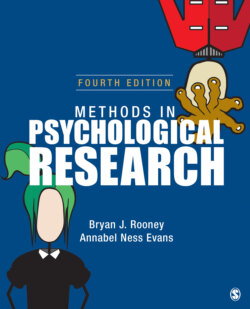Читать книгу Methods in Psychological Research - Annabel Ness Evans - Страница 6
На сайте Литреса книга снята с продажи.
ОглавлениеPreface
Planning the fourth edition of this book was pretty easy for us; we have streamlined our process and yell at each other only on occasion. The reviews of the previous editions were very positive, and the book was doing well, so we were not surprised to learn that we were going into a new edition. Users of the book were very happy with it, and, more important, our students were also. We wrote this book to meet the needs of our students, and every revision to this book was made to meet that same purpose.
Although there are some great methods books available, none are perfectly suited to our course. We take an applied approach in the course, and our students are required to complete research projects. As such, Chapter 13 was written specifically for students who are expected to conduct or propose a research project as part of their course requirements. Instructors who do not require students to conduct or propose a research project could omit Chapter 13. However, we strongly recommend that students conduct a research project and write it up following American Psychological Association (APA) style. Our students find this exercise extremely valuable, and we include a lot of the supporting material we provide our students in Chapters 13 and 14.
In Chapter 13, we discuss, with worked-through examples, basic statistical procedures that students doing research projects would be likely to use to analyze their data. We also cover statistical procedures that students who are reading the literature will need to understand the more complex analyses used by social scientists (Chapter 2), but we have written the book with the expectation that students have taken an introductory statistics course. Basic statistical concepts for students who have not taken statistics (and for those who need a refresher) can be found in Chapters 2, 4, and 13.
What’s New in the Fourth Edition
We read the reviews of the third edition on a lovely summer day on Annabel’s back deck. We have always agreed that making changes just for the sake of change is not useful and therefore not in our wheelhouse. We made the changes that we both agreed would be helpful to the professors using our book and the students learning from it.
Because we both believe that the book is sound, we did not make major changes to its format or content. We replaced some of the older research articles with more current examples. We have found that it is getting harder and harder to find really good examples of the research designs we are teaching in this book. For that reason, we have retained some older excellent examples.
APA Formatting and Style
We have followed the recommendations of the 6th edition of the APA publication manual as closely as possible in our reporting of statistics, tables, and figures, within the confines of SAGE’s design style. In addition, we discuss the style and manuscript requirements of the APA in some detail in Chapter 14.
End-of-Chapter Material
Answers to Conceptual Exercises
Throughout the text, you will find mini-exercises that ask students to think critically about the material they have just read. We have provided our suggested answers to these questions at the end of each chapter. There may be other good answers to some of the conceptual exercises. If students’ answers differ from ours, they should not assume that they are necessarily wrong. They should consult their instructor.
FAQ
The FAQ sections that accompany each chapter are very popular with students. We have compiled the questions most often asked by our students and worded those questions as our students do. We have answered the questions as we do in class.
Chapter Exercises and Projects
We have included the chapter exercises and projects that our students have reported, over the years, to be most useful to them.
Our students appreciate the student-friendly style of our book, and we hope you and your students do also.
Ancillaries
Student Study Site
The open-access, free student study site provides additional support to students who are using this book. Each chapter in the text is accompanied by a self-quiz on the website, which includes multiple-choice questions. In addition, e-flashcards and learning objectives are included. Web resources are provided for additional information and support. SAGE journal articles are also available to help students use original research. You can visit the study site at edge.sagepub.com/rooney4e.
Instructor Teaching Site
This password-protected resource provides a number of helpful teaching aids for professors who are new to teaching research methods or to using this book. Included are PowerPoint slides, a test bank, lecture notes, sample syllabi, and suggested web resources. You can access the site at edge.sagepub.com/rooney4e.
—Bryan J. Rooney and Annabel Ness Evans
